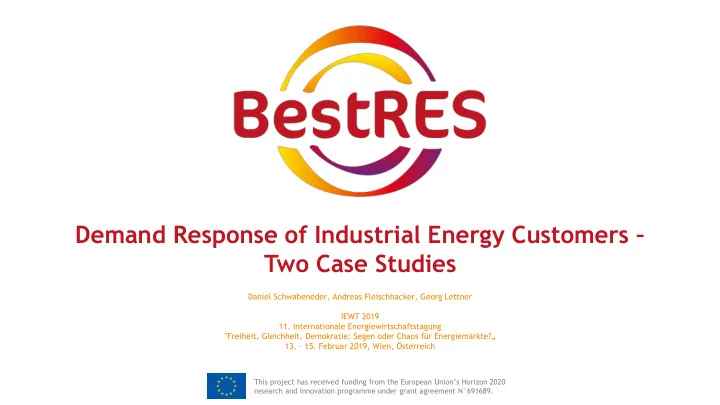

Demand Response of Industrial Energy Customers – Two Case Studies Daniel Schwabeneder, Andreas Fleischhacker, Georg Lettner IEWT 2019 11. Internationale Energiewirtschaftstagung "Freiheit, Gleichheit, Demokratie: Segen oder Chaos für Energiemärkte ?„ 13. – 15. Februar 2019, Wien, Österreich This project has received funding from the European Union’s Horizon 2020 research and innovation programme under grant agreement N°691689.
Overview • Motivation – Introduction to the BestRES project • Methods • Example 1 – Activation of end users ‘ flexibility in Portugal • Example 2 – Using Flexibilities of customers as third party • Conclusions 2
Motivation Intoduction to the BestRES project
Motivation The BestRES project investigates and aims to improve business models for aggregators of RES and flexible demand. 4
Motivation Improved business models that have been developed within the consortium: Automation and control Providing decentralized units Demand Side flexibilization of access to balancing markets small customers “Peer -to- peer” (local) energy Market renewables on Invest and market distributed matching multiple market places generation of customers in apartment houses Dispatch flexible generation Trading PV and Wind power Activation and marketing of under changing market design end user’s flexibility. on multiple markets Suppling „mid - scale“ Using flexibility of customers Pooling flexibility for local customers with time variable as third party balancing market and energy tariffs including grid charges service provision. optimization Demand side flexibilisation of Demand side flexibilisation of households and small customers medium and large-scale customers 5
Methods
Methods For the evaluation of improved business models we use Femto: • A modeling framework to construct linear and mixed-integer optimization models to simulate the operation of aggregators on different markets • Flexibly adaptable for different aggregator portfolios (production, storage, flexible loads) and markets (day-ahead, reserve and intraday) • Written in the Julia language • Developed at Energy Economics Group (TU Wien) 7
Example 1 Activation and marketing of end user’s flexibility.
Case study description EDP Portugal wants to use the flexibility of medium and large-scale customers to reduce cost for energy procurement. We analyzed the following options to valorize flexibility: • Spot : Day-ahead spot market Increase load during hours of low prices and reduce it during high market prices. Imbalance : Imbalance reduction • Increase load when EDP has positive imbalance and reduce it during hours of negative imbalance. Optimal: • Theoretical scenario (assuming perfect foresight of imbalance prices) and choosing the best option between Spot and Imbalance. 9
Model scaling Load and market data from the year 2016. Flexibility assumptions Heat Water Other Max. load change ± 10% ± 0.1 MW Max. number of activations 2 per day 3 per day Max. duration of activations 15 min 2 h Equilibrium period Day Day Week 10
Flexibility Activations Spot Imbalance 11
Results: Cost reduction • The Spot and the Imbalance scenario achieve quite similar results The Optimal scenario shows the potential improvement if information on imbalance prices were available • 12
Results: CO2 Change in average CO2 emissions of electricity consumed by the loads. Source: Actual generation per power plant type for Portugal (ENTSO-E) Emission factors per power plant type (IPCC) 13
Results: CO2 Why the increase in CO2? 14
Example 2 Using flexibility of customers as third party
Using flexibility of customers as third party In this case study Next Kraftwerke Belgium (NKW-B) wants to use the flexibility electricity customers as third party. This means that customers and their supplier belong to a different Balance Responsible Party (BRP) than the aggregator NKW-B. Hence, flexibility activations by NKW-B might cause imbalances in the supplier‘s BRP and change the revenue from energy supply. 16
Model scaling Load and market data from the year 2017 Flexibility assumptions Lighting Cooling Industry Max. load change ±5 0% ± 0.1 MW ± 0.2 MW Max. number of activations 4 per day 10 per week Max. duration of activations 1 h 4 h Availability 8 PM – 6 AM Equilibrium period Day Day Week 17
Scenarios • Baseline – No flexibility activations at all • Spot – Flexibility is used for day-ahead spot market optimization – We assume a bilateral contract between the supplier and the 3rd party aggregator: • The aggregator has to announce activations day-ahead no imbalances for the supplier. • Changes in customer metering are compensated via a supply transfer payment. • Reserve – Flexibilites are used for the R3+ reserve market. – Elia already cancels out supplier imbalances caused by the aggregator. – Load flexibilities are prioritized. A 1 MW diesel generator is used as backup – We assume shift-able loads. Hence reserve activations have to be balanced. This is done on the intraday market. 18
Results Baseline 19
Results Spot 20
Results Reserve 21
Spot and Reserve benefits • The Reserve scenario provides more benefits than the Spot scenario. However, most of the reserve benefits are provided by the diesel generator and flexible loads • perform better in the Spot scenario. • Both scenarios result in benefits for aggregator and customers and neither increases the cost of the supplier. • The benefits of the business models can be divided among customer and aggregator. 14/02/2019 22
Conclusions
Summary and Conclusions • Flexible energy demand can be used in various ways to generate profit or reduce cost on different energy markets. • Load shifting with respect to market prices does not necessarily result in CO2 reduction. Third party access to flexibility requires bilateral contracts or a legal framework for • transfer payments. Demand side flexibilization can result in win-win situations among multiple actors • 24
Thank you! Daniel Schwabeneder TU Wien Institute of Energy Systems and Electrical Drives Energy Economics Group (EEG) Schwabeneder@eeg.tuwien.ac.at
Recommend
More recommend